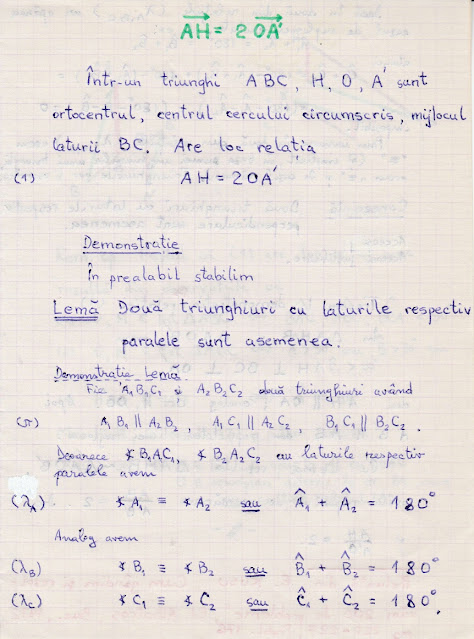(filipineza)
The name "EULER's Lemma" is given by me. This property of the circumcenter and the orthocenter is used in the demonstration of the "Circle of the Nine Points Theorem".
THEOREM (EULER's Lemma)
"We denote by O, G and H respectively the center of the
circumscribed circle, the center of gravity and the orthocenter
of a triangle ABC.
Let A' be the midpoint of side [BC]. We have equality
$$AH=2\cdot OA'. " \tag {e}$$
Rem CiP
In reality we have more, the relationship between vectors takes place
$$\overrightarrow{AH}=2 \cdot \overrightarrow{OA'}. \tag {E}$$
CiP Proof (following the text from the images at the beginning)
First we demonstrate
Lemma 1 Two triangles with respectively parallel sides are similar.
Proof of Lemma_1
Let $A_1B_1C_1$ and $A_2B_2C_2$ be two triangles having
$$A_1B_1 \parallel A_2B_2\;,\;\;A_1C_1 \parallel A_2C_2\;,\;\;B_1C_1 \parallel B_2C_2\;. \tag{$\pi$}$$
Since [the angles] $\angle B_1A_1C_1,\;\angle B_2A_2C_2$ have respectively parallel sides, we have
$$\angle A_1 \equiv \angle A_2\;\;\;or \;\;\;\measuredangle A_1+\measuredangle A_2=180^{\circ} \tag {$\lambda_A$}$$
Analogously we have
$$\angle B_1 \equiv \angle B _2\;\;\;or \;\;\; \measuredangle B_1+\measuredangle B_2=180^{\circ} \tag{$\lambda_B$};$$
$$\angle C_1 \equiv \angle C_2\;\;\;or \;\;\; \measuredangle C_1+\measuredangle C_2=180^{\circ} . \tag{$\lambda_C$}$$
If in two of the relations $(\lambda_{A,B,C}$ the case of supplementarity would appear, e.g.
$$\measuredangle A_1+\measuredangle A_2=180^{\circ}=\measuredangle B_1+\measuredangle B_2$$
then
$\measuredangle C_1+\measuredangle C_2=180^{\circ}-(\measuredangle A_1+\measuredangle B_1)+180^{\circ}-(\measuredangle A_2+\measuredangle B_2)=(180^{\circ}-\measuredangle A_1-\measuredangle A_2)+(180^{\circ}-\measuredangle B_1-\measuredangle B_2)=0$
impossible.
Therefore, in two of the relations $(\lambda_{A,B,C})$ we have $"\equiv "$ (and implicitly, based on the sum of the angles of a triangle we have $"\equiv "$ in the remaining case as well). The triangles will be similar.
$\square $<end Proof of L_1>
Lemma 2 Two triangles with respective perpendicular sides are similar.
Same justification.
Proof of (e) [apud E. RUSU, "Cum gindim si rezolvam 200 de probleme", Ed. Albatros, Buc., 1972, pp 226-227, Probl. 176]
In [the triangles] $\Delta AHB$ and $\Delta A'OB'$ we have
$$AH \perp BC \perp OA'$$
so $AH \parallel AB$; analogous $BH \parallel OB'$. Then $A'B' \parallel AB$ from the middle theorem.
With the Lemma 1 result $\Delta AHB \sim \Delta A'OB'$, having the similarity ratio $\frac{AB}{A'B'}=2.$ So also $\frac{AH}{A'O}=2.$
Remark CiP The fact that (e) also occurs as vectors (i.e. (E)) results from the observations:
($\alpha$) $O,\;H\;\in Int \Delta ABC\;\;\Leftrightarrow\;\widehat{BAC},\;\widehat{ABC},\;\widehat {BCA}\;<90^{\circ}$
($\beta$) $O,\;H\;\in Ext \Delta ABC\;\;\Leftrightarrow\;\widehat{A}\;>90^{\circ}\;or\;\widehat{B}\;>90^{\circ}\;or\; \widehat{C}\;>90^{\circ}$
($\gamma$) $H=A,\;O=A'\;\;\Leftrightarrow\;\widehat{A}=90^{\circ}.$
Moreover, in the case $(\beta)$ we can specify:
$\widehat{BAC}>90^{\circ}\;\Rightarrow\;H\in Int \{opposite\;angle\;at\;the\;apex\;with\; \angle BAC\}$
and $O\in \{the\;half-plane\;determined\;by\;the\; line\;BC,\;which\;does\;\underline{not}\;contain\;the\;vertex\;A \}$
$\blacksquare \blacksquare$





Niciun comentariu:
Trimiteți un comentariu